How to generate ideas?
Igor Byttebier (Byttebier & Vullings, 2007), former director of COCD and creativity trainer, describes creative thinking as follows: “creative thinking is made up of different attitudes, thinking skills and techniques, and thought processes that increase the probability of pattern breaking and the creation of new connections in our brain”. Breaking patterns and the creation of new connections is depicted in a set of watercolors. See figure.
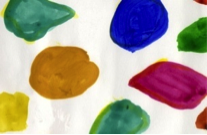

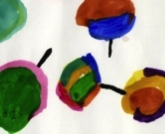
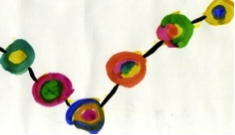
These four watercolors depict the detaching and reconnection of thoughts.
In “The act of creation’’ Arthur Koestler (1976) explains the mechanism of creating ideas by changing the “frames of reference’’ or “matrices’’: “A blending of elements drawn from two previously unrelated matrices of thought into a new matrix of meaning by way of a process involving comparison, abstraction and categorization, analogies and metaphors”. For example: A paperclip can be used to hold several sheets of paper together, but also to open something (tool) or to hang something up (attaching). Koestler also refers to this framing mechanism as “bisociating”: “Rather than creating something from nothing, the creative act discovers, makes a choice, regroups, combines, produces a synthesis of existing facts, ideas, possibilities, skills.”
The figure presents an example of how, using the same basic elements (letters), new configurations can be created by means of specific framing (new words or specific shapes). Regrouping the letters not only results in an anagram, but also in completely different shapes.


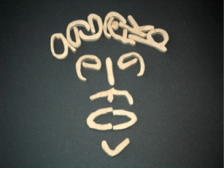

Regrouping the (Dutch) letters creative thinking into different configurations.
In the literature, the creative act – creative thinking – is described using activities characterized as generative, divergent, lateral and right brain. The other type of thinking is critical thinking, which is characterized as analytic, convergent, vertical and left brain. (Harris, 1998)
Another name for creative thinking is lateral thinking. This term was coined by De Bono (1970) and complements vertical thinking. De Bono described the differences between these two styles of thinking as follows: Vertical thinking is selective, moves only if there is a direction in which to move, is analytical & sequential, every step must be correct, is a finite process, etc. Lateral thinking is generative, moves in order to generate a direction, is provocative, can make jumps, not every step needs to be correct, is a probabilistic process, etc.
Right-brain thinking in construction is a necessary skill (Kirk & Mulligan, 1996). Professionals are well trained in skills related to the left brain, and less so in skills related to the right brain.
Creativity can be looked at from different points of view. Treffinger, Young, Selby, and Shepardson (2002) (p. 9), distinguish five types of creativity that can emphasize: people (Fromm), cognitive processes or operations (Guilford, Torrance), lifestyle or personnel development (Maslow, Rogers), product (Gardner, Khatena) and interactions among people, processes, situations, and outcomes (Amabile, Rhodes). The references can be found in (Treffinger et al., 2002).
Successful creative thinking requires a number of skills: creative observation, postponing judgment, diverging, developing imagination, and flexible development. The Creativiteit HOE? ZO! manual (Byttebier, 2002) presents examples of ways in which these skills can be acquired. With collaborative creative thinking, a number of rules must be complied with:
- Postpone judgment
- Foster openness within the creative group
- Pay extra attention to naive ideas
- No hierarchy, no arrogance
- Hitchhike on other ideas
- Making a mistake is allowed
The yellow card was used in experiments conducted by the researcher during creative meetings. See figure. Participants can issue a yellow card to warn that the rules are being violated.
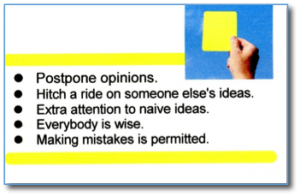
Yellow card for a creative meeting. (Adapted from COCD’s Black Card)
References:
Byttebier, I., & Vullings, R. (2007). Creativity today. Amsterdam: BIS Publishers.
Koestler, A. (1976). The act of creation (2nd Danube Reprinted ed. ed.). London [etc.]: Hutchinson & Co.
Harris, R. (1998). Introduction to Creative Thinking. from http://www.virtualsalt.com/crebook1.htm
De Bono, E. (1970). Lateral thinking : creativity step by step. New York, NY, USA: Harper & Row.
Kirk, W. M., & Mulligan, D. (1996). Teaching Right-Brain Thinking in a Construction Curriculum. Journal of Construction Education, 1(1), p. 11-22.
Treffinger, D. J., Young, G. C., Selby, E. C., & Shepardson, C. (2002). Assessing creativity: A guide for educators. Storrs, CT, USA: The National Research Center on the Gifted and Talented, University of Connecticut.
Byttebier, I. (2002). Creativiteit Hoe? Zo! : inzicht, inspiratie en toepassingen voor het optimaal benutten van uw eigen creativiteit en die van uw organisatie. Tielt: Lannoo.
